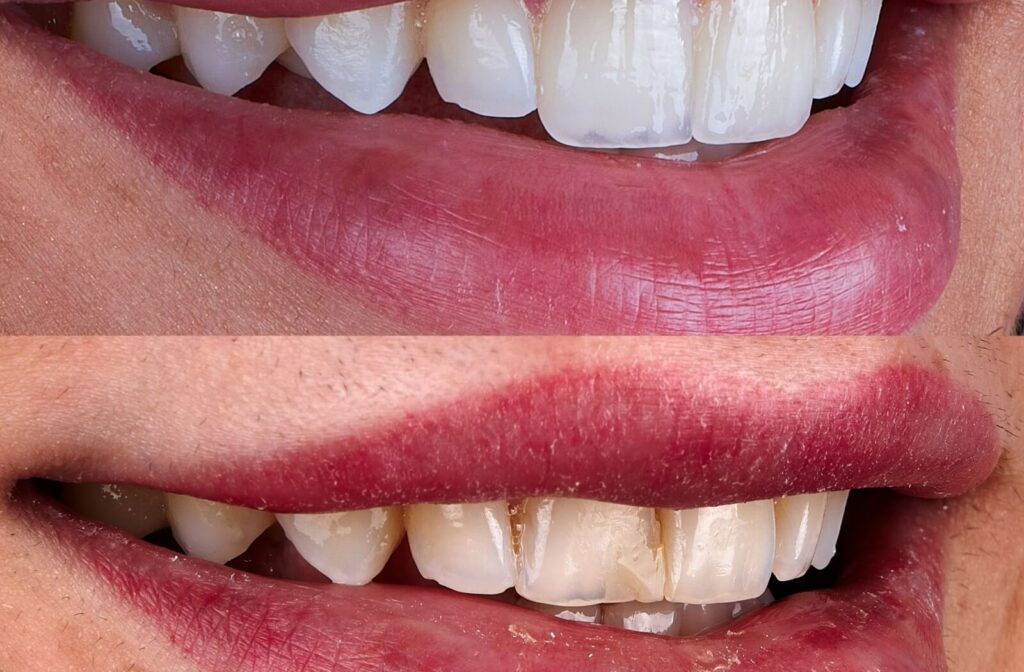A confident smile can make a lasting impression, but chips, stains, or gaps can sometimes hold you back. Cosmetic dentistry can offer a variety of ways to refresh your smile, with two popular options being bonding and veneers. While both treatments are designed to improve the look of your teeth, they serve different purposes.
Bonding is ideal for fixing small imperfections like chips, cracks, or discolouration. Veneers, on the other hand, offer a more extensive, long-lasting solution for concerns such as severe staining, larger gaps, or unevenly shaped teeth.
What Is Teeth Bonding?
Teeth bonding is a non-invasive cosmetic dental procedure that uses a tooth-coloured composite resin to restore or enhance your smile. The resin is carefully shaped to match your natural tooth, then hardened with a special light to create a strong, seamless bond.
Bonding is a popular choice for people looking to make small cosmetic improvements or repairs. It can be a quick and relatively affordable option to address:
- Chips
- Cracks
- Stains or discolouration
- Small gaps
- Minor misalignments
One of the biggest advantages of bonding is that it can usually be completed in just one visit, making it a convenient choice if you’re looking for fast results without extensive treatment.
What Are Veneers?
Veneers are thin, custom-made shells that are bonded to the front surfaces of your teeth. They’re typically made from porcelain or composite resin and are designed to enhance your smile by covering imperfections or creating a more uniform, symmetrical appearance.
Compared to bonding, veneers are often used for more significant cosmetic changes. They may be a good option for:
- Severely stained or discoloured teeth
- Large gaps between teeth
- Crooked or misshapen teeth
- Teeth that appear too short or uneven
Because veneers offer a more comprehensive aesthetic transformation, treatment usually requires two or more visits. The process also involves some tooth preparation, where a small amount of enamel is removed for a better natural look and comfortable fit.
Materials Used for Veneers
Veneers can be made from different materials, with the most common being:
- Porcelain: Strong, durable, and stain-resistant, porcelain veneers are a popular choice for long-lasting results.
- Composite resin: Similar to the material used in dental bonding, composite veneers are generally more affordable and can be colour-matched to your natural teeth. However, they may not last as long as porcelain veneers.
Choosing Between Bonding and Veneers
While both bonding and veneers can enhance the appearance of your teeth, they serve different purposes depending on the changes you’re looking for. Bonding can work for minor cosmetic fixes, while veneers can provide a more complete smile transformation.
Cosmetic Enhancements
Bonding is well-suited for small imperfections like chips, cracks, or minor discolouration. It’s often a good choice for people with healthy teeth who want to make subtle improvements. Veneers, on the other hand, are better for more significant aesthetic changes, such as closing larger gaps, masking severe discolouration, or reshaping crooked or uneven teeth.
Durability & Longevity
With proper care, both treatments can last for years, but veneers are generally more durable. Porcelain veneers, in particular, are resistant to stains and wear, making them a great choice for long-term results. Bonding may wear down more quickly and sometimes requires touch-ups or replacement over time.
Procedure & Commitment
Bonding is a quick, minimally invasive procedure that can usually be completed in a single visit, making it an appealing choice for fast, affordable results. Veneers require more preparation, including removing a small amount of enamel, and are usually completed over multiple visits. While they involve a bigger commitment, veneers can provide a longer-lasting and more dramatic change.
Cost
Bonding is generally more affordable upfront, especially considering the materials used. However, because bonding may need more maintenance over time, the long-term cost can add up. Veneers have a higher initial cost but are typically more durable, which can make them more cost-effective in the long run.

Caring for Your Bonding or Veneers
Whether you choose bonding or veneers, good oral hygiene is essential for keeping your smile looking beautiful. Here are some simple care tips:
- Brush twice a day with fluoride toothpaste and a soft-bristled toothbrush.
- Floss daily to remove food particles and plaque.
- Avoid hard foods and habits like nail-biting or chewing ice, which run the risk of chipping or cracking bonded teeth and veneers.
- Visit your dentist regularly for checkups and professional cleanings.
- Drink plenty of water to help rinse away food particles and reduce staining.
- Avoid smoking or chewing tobacco to maintain a bright, healthy smile.
- Limit foods and drinks that cause stains, such as coffee, tea, and red wine.
Your dentist may also suggest extra precautions based on your specific treatment to help protect your bonding or veneers from damage and discolouration.
Ready to Refresh Your Smile?
Whether you’re looking for a quick touch-up or a complete smile transformation, both bonding and veneers can deliver beautiful results when tailored to your needs. The right choice depends on the changes you’d like to make, your lifestyle, and your long-term goals for your smile.
Our team at Upper Gage Dental Centre is here to guide you through your options and help you feel confident in your decision. Book an appointment today to discuss bonding, veneers, or other treatments that can help you achieve a smile you’ll be proud to share.



